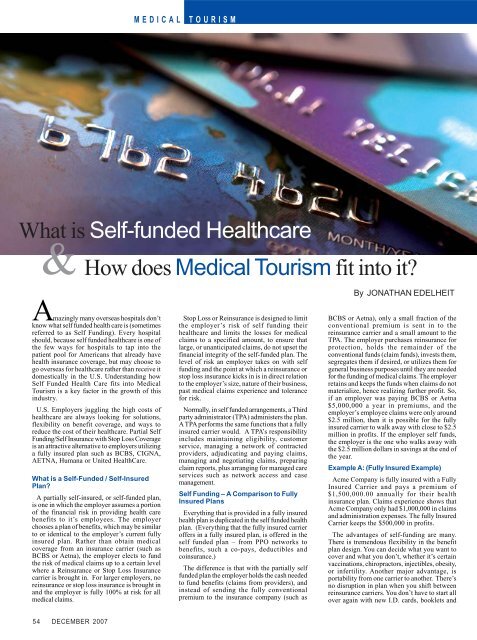Download PDF - Medical Tourism Magazine
Download PDF - Medical Tourism Magazine
Download PDF - Medical Tourism Magazine
You also want an ePaper? Increase the reach of your titles
YUMPU automatically turns print PDFs into web optimized ePapers that Google loves.
MEDICAL TOURISM<br />
What is Self-funded Healthcare<br />
&<br />
Amazingly many overseas hospitals don’t<br />
know what self funded health care is (sometimes<br />
referred to as Self Funding). Every hospital<br />
should, because self funded healthcare is one of<br />
the few ways for hospitals to tap into the<br />
patient pool for Americans that already have<br />
health insurance coverage, but may choose to<br />
go overseas for healthcare rather than receive it<br />
domestically in the U.S. Understanding how<br />
Self Funded Health Care fits into <strong>Medical</strong><br />
<strong>Tourism</strong> is a key factor in the growth of this<br />
industry.<br />
U.S. Employers juggling the high costs of<br />
healthcare are always looking for solutions,<br />
flexibility on benefit coverage, and ways to<br />
reduce the cost of their healthcare. Partial Self<br />
Funding/Self Insurance with Stop Loss Coverage<br />
is an attractive alternative to employers utilizing<br />
a fully insured plan such as BCBS, CIGNA,<br />
AETNA, Humana or United HealthCare.<br />
What is a Self-Funded / Self-Insured<br />
Plan?<br />
A partially self-insured, or self-funded plan,<br />
is one in which the employer assumes a portion<br />
of the financial risk in providing health care<br />
benefits to it’s employees. The employer<br />
chooses a plan of benefits, which may be similar<br />
to or identical to the employer’s current fully<br />
insured plan. Rather than obtain medical<br />
coverage from an insurance carrier (such as<br />
BCBS or Aetna), the employer elects to fund<br />
the risk of medical claims up to a certain level<br />
where a Reinsurance or Stop Loss Insurance<br />
carrier is brought in. For larger employers, no<br />
reinsurance or stop loss insurance is brought in<br />
and the employer is fully 100% at risk for all<br />
medical claims.<br />
54 DECEMBER 2007<br />
How does <strong>Medical</strong> <strong>Tourism</strong> fit into it?<br />
Stop Loss or Reinsurance is designed to limit<br />
the employer’s risk of self funding their<br />
healthcare and limits the losses for medical<br />
claims to a specified amount, to ensure that<br />
large, or unanticipated claims, do not upset the<br />
financial integrity of the self-funded plan. The<br />
level of risk an employer takes on with self<br />
funding and the point at which a reinsurance or<br />
stop loss insurance kicks in is in direct relation<br />
to the employer’s size, nature of their business,<br />
past medical claims experience and tolerance<br />
for risk.<br />
Normally, in self funded arrangements, a Third<br />
party administrator (TPA) administers the plan.<br />
A TPA performs the same functions that a fully<br />
insured carrier would. A TPA’s responsibility<br />
includes maintaining eligibility, customer<br />
service, managing a network of contracted<br />
providers, adjudicating and paying claims,<br />
managing and negotiating claims, preparing<br />
claim reports, plus arranging for managed care<br />
services such as network access and case<br />
management.<br />
Self Funding – A Comparison to Fully<br />
Insured Plans<br />
Everything that is provided in a fully insured<br />
health plan is duplicated in the self funded health<br />
plan. (Everything that the fully insured carrier<br />
offers in a fully insured plan, is offered in the<br />
self funded plan – from PPO networks to<br />
benefits, such a co-pays, deductibles and<br />
coinsurance.)<br />
The difference is that with the partially self<br />
funded plan the employer holds the cash needed<br />
to fund benefits (claims from providers), and<br />
instead of sending the fully conventional<br />
premium to the insurance company (such as<br />
By JONATHAN EDELHEIT<br />
BCBS or Aetna), only a small fraction of the<br />
conventional premium is sent in to the<br />
reinsurance carrier and a small amount to the<br />
TPA. The employer purchases reinsurance for<br />
protection, holds the remainder of the<br />
conventional funds (claim funds), invests them,<br />
segregates them if desired, or utilizes them for<br />
general business purposes until they are needed<br />
for the funding of medical claims. The employer<br />
retains and keeps the funds when claims do not<br />
materialize, hence realizing further profit. So,<br />
if an employer was paying BCBS or Aetna<br />
$5,000,000 a year in premiums, and the<br />
employer’s employee claims were only around<br />
$2.5 million, then it is possible for the fully<br />
insured carrier to walk away with close to $2.5<br />
million in profits. If the employer self funds,<br />
the employer is the one who walks away with<br />
the $2.5 million dollars in savings at the end of<br />
the year.<br />
Example A: (Fully Insured Example)<br />
Acme Company is fully insured with a Fully<br />
Insured Carrier and pays a premium of<br />
$1,500,000.00 annually for their health<br />
insurance plan. Claims experience shows that<br />
Acme Company only had $1,000,000 in claims<br />
and administration expenses. The fully Insured<br />
Carrier keeps the $500,000 in profits.<br />
The advantages of self-funding are many.<br />
There is tremendous flexibility in the benefit<br />
plan design. You can decide what you want to<br />
cover and what you don’t, whether it’s certain<br />
vaccinations, chiropractors, injectibles, obesity,<br />
or infertility. Another major advantage, is<br />
portability from one carrier to another. There’s<br />
no disruption in plan when you shift between<br />
reinsurance carriers. You don’t have to start all<br />
over again with new I.D. cards, booklets and


